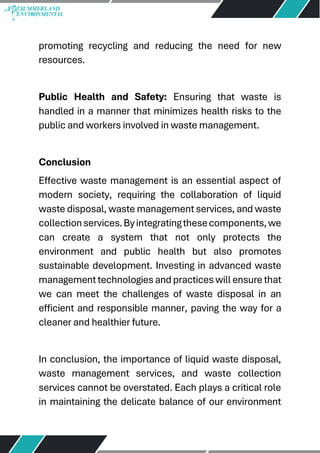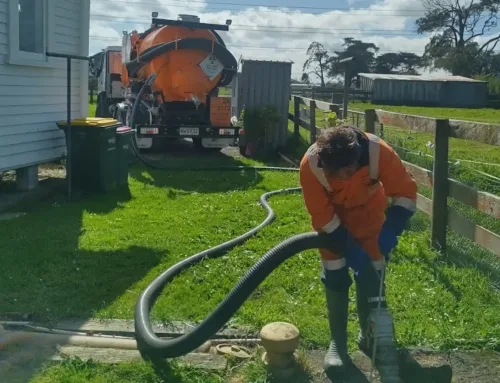10 Simple Techniques For Reclaim Waste
10 Simple Techniques For Reclaim Waste
Blog Article
Some Of Reclaim Waste
Table of ContentsThe 7-Second Trick For Reclaim WasteThe 4-Minute Rule for Reclaim WasteMore About Reclaim WasteThe Ultimate Guide To Reclaim WasteAll about Reclaim Waste
Residential sewer waste refers to the waste and products from a property septic tank. The appropriate management and disposal of domestic sewer waste call for liquid waste to be transferred to a sewer therapy plant where the proper approaches and devices are applied to detoxify and dispose of waste.
Commercial waste usually includes prospective threats, such as flammable materials or a blend of fluid and solid waste products, and needs an extra innovative and detailed disposal process. The disposal of commercial waste usually involves the filtering of waste before transportation to make sure secure and proper disposal. Industrial waste is produced from by-products and drainage of commercial procedures and manufacturing.
This kind of waste can not use the exact same sewage administration transport or procedures as septic or business fluids. The commercial waste monitoring procedure calls for the inspection and screening of fluid waste prior to it undertakes the disposal procedure (liquid waste removal melbourne). Runoff waste is the liquid waste that comes from drainage and excess stormwater in extremely inhabited areas or cities
Overflow waste can trigger contamination and flooding otherwise taken care of properly. Learn more about sewer cleaning and waste management. Guaranteeing appropriate waste administration can avoid calamities and decrease environmental harm. Both individuals in domestic settings and specialists in business or manufacturing markets can benefit from understanding the procedures and guidelines of fluid waste monitoring.
Getting My Reclaim Waste To Work
Get in touch with PROS Providers today to learn more about our waste monitoring and disposal services and the appropriate means to look after the liquid waste you create.
(https://reclaimwaste1.start.page)This supposed 'wastewater' is not only a vital source but, after treatment, will be released to our land, rivers or the sea. Used water from commodes, showers, bathrooms, cooking area sinks, washings and commercial processes is understood as wastewater.

water used to cool equipment or clean plant and equipment). Stormwater, a kind of wastewater, is runoff that streams from agricultural and metropolitan locations such as roofings, parks, yards, roads, paths and gutters into stormwater drains pipes, after rainfall. Stormwater official site flows unattended directly to regional creeks or rivers, at some point getting to the ocean.
The Greatest Guide To Reclaim Waste
In Queensland, many wastewater is dealt with at sewer therapy plants. Wastewater is transported from domestic or industrial websites with a system of sewers and pump stations, called sewerage reticulation, to a sewage treatment plant. Local governments build, maintain and run most sewer therapy plants. Operators are certified under the Environmental Management Act 1994 to release treated wastewater at an acceptable environmental standard right into rivers.
The Department of Natural Resources recommends local governments about handling, operating and preserving sewerage systems and treatment plants. In unsewered locations, regional governments might need householders to install specific or family sewage therapy systems to deal with domestic wastewater from toilets, kitchens, restrooms and washings. The Division of Natural Resources authorises making use of house systems when they are confirmed to be efficient.
Many stormwater receives no therapy. In some new subdivisions, therapy of some stormwater to remove clutter, sand and gravel has actually begun using gross contaminant traps. Wastewater therapy occurs in 4 stages: Gets rid of solid issue. Larger solids, such as plastics and various other items wrongly released to sewers, are gotten rid of when wastewater is gone through displays.
Wastewater then streams right into large storage tanks where solids resolve and are removed as sludge. Oil and residue are skimmed from the surface area. Utilizes small living microorganisms recognizes as micro-organisms to damage down and remove staying liquified wastes and great particles. Micro-organisms and wastes are integrated in the sludge. Gets rid of nitrogen and phosphorus nutrients that could trigger algal blossoms in our rivers and endanger water life.
7 Simple Techniques For Reclaim Waste
Nutrient elimination is not offered whatsoever sewage treatment plants since it needs expensive specialised equipment. It is becoming more common in Queensland. Clear fluid effluent generated after therapy may still include disease-causing micro-organisms. If this effluent is released right into rivers such as rivers or the sea, the micro-organisms will ultimately die out.

Many wastewater flows right into the sewage system. Under the Act, neighborhood federal governments administer authorizations and licences for ecologically relevant activities (ERAs) including wastewater releases that may have a neighborhood effect.
Unknown Facts About Reclaim Waste
Surveillance provides factual details concerning water quality and can confirm that permit problems are being fulfilled. The info acquired with monitoring offers the basis for making water quality decisions.
Report this page